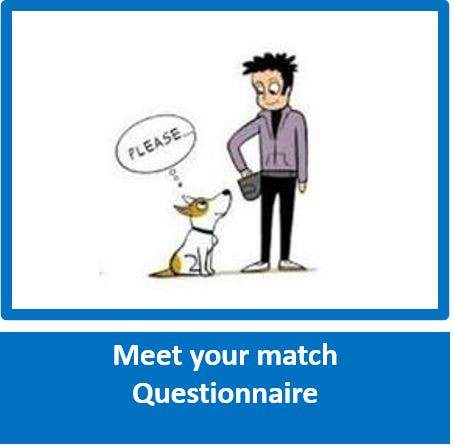|
So often a shelter dog is a mixed breed, and by finding out it's Breed Make-up. will help you to determine whether your existing dog and the new dog will be compatible. Additionally, you can find out what exercise will suit the best, any breed health concerns, any genetic concerns, and also any behaviour quirks the breeds may be prone too. DNA test is simple to do, and can be done in the comfort of your own home. Do have a look at your website, and don't hesitate to contact us if any questions. www.muttmix.co.za
|
Why it is so important for shelters to really ensure that the dog and potential owner will be a perfect match
by Friends of the Dog - Scotty Valadao
by Friends of the Dog - Scotty Valadao
 Pic -
Fallen Angels
Pic -
Fallen Angels
When dogs are confined to a shelter, they do experience multiple emotions that can affect their emotional health in the short term, and also confinement in a shelter can a have long-term mental impact. Imagine, what the psychological damage is when a dog is adopted-out (more change and stress), and then when the adoption does not work out, the dog is returned to the shelter – more stress, and the more the dog is returned, the more the likelihood of additional behaviours occurring, and the dog becomes less likely to have a successful adoption.
That is one side of the story, what about the impact that an unsuccessful adoption can have on those that actually adopted the dog?
In a scientific report that we came across where we have given you the full link to at the bottom, as well worth a read, they state that the most common reasons that people return dogs are:
So how did the above affect the owners likelihood of adopting again
In the study done, all the participants found the decision to return the dog to the shelter very difficult, which is totally understandable – can you imagine the heartbreak, the stress of the decision, kids being upset, the guilt, the sense of failure, when all they wanted to do if give a shelter dog a loving home! This experience could possibly have a major impact on whether these owners would run the risk of adopting an adult dog from a shelter again. From our own experience, we have found that in failed adoptions where dog was returned, especially for behaviour problems, the people that really do want a dog, prefer to look for a puppy as opposed to an adult dog, and not always from a shelter.
Of all the participants in the study, regardless of why they returned the dog, there were a whopping 41% who said they would not adopt again, plus a further 13% were not sure if they would go this route again.
So, what can be done?
Improve the manner in which shelters do their checks as to whether the dog will suit the home, the family, and any existing pets. We have been very blessed, in that the shelters and breed rescue organizations that we have worked with, have taken on board as many as our recommendations as possible, and done all they could to ensure the dog is a perfect fit. However, we don’t think that all the shelters and breed rescue are doing much more than checking out if the dogs will get on by a meeting in an neutral area, doing a home check, and trying to get the best match by way of male and female together. Some of the more important aspects that should be looked at are:
Anybody working with animal welfare knows what a hard, tiring, time consuming, and very often emotional draining job, working in a shelter actually is. There is seldom enough time, enough hands or money to get all the things they need to get done, never mind changing a dog’s existing behaviour and teaching them basic manners, and/or changing any unacceptable behaviours.
This is where we ask all behaviourists, behaviour students, trainers etc, to really try and get involved with working with shelters and breed rescue and help them to provide basic training before the dog goes home, and assist in changing any behaviour concerns – even if you just work with one dog at a time. At Fallen Angels, we brought in a Behaviour Session for all new owners, including some basic obedience, the day they took the dog home, and provided the owners with 'after care', where they could contact us if experience any problems - this was a tremendous success.
These things all take time, but if all of us can do a little, we are supplying knowledge and information, and the end result will be of immense benefit to dogs, and less dogs should be returned.
Full article
In a scientific report by “Powell, L., Reinhard, C.L., Satriale, D. et al. The impact of returning a pet to the shelter on future animal adoptions. Sci Rep 12, 1109 (2022). https://doi.org/10.1038/s41598-022-05101-5”
That is one side of the story, what about the impact that an unsuccessful adoption can have on those that actually adopted the dog?
In a scientific report that we came across where we have given you the full link to at the bottom, as well worth a read, they state that the most common reasons that people return dogs are:
- Behaviour problems were the most common reason dogs were returned, and mostly within a 3-month period. When we bring a dog into our homes, we have what is called the Honeymoon Period – this is normally a period, that on average is 3 weeks, but can go onto 3 to 6 months, where either the behaviour concern is exhibited at very low frequency and intensity, or not exhibited at all. A bit like being on your best behaviour with new people, until you relax and start to act more like you normally would with friends.
- Another reason for returns were that there was incompatibility between existing and new dog.
- An interesting one was that the dog did not meet the owners expectations.
- Other reasons for returning were the owners health, the dog’s health and also relocating.
So how did the above affect the owners likelihood of adopting again
In the study done, all the participants found the decision to return the dog to the shelter very difficult, which is totally understandable – can you imagine the heartbreak, the stress of the decision, kids being upset, the guilt, the sense of failure, when all they wanted to do if give a shelter dog a loving home! This experience could possibly have a major impact on whether these owners would run the risk of adopting an adult dog from a shelter again. From our own experience, we have found that in failed adoptions where dog was returned, especially for behaviour problems, the people that really do want a dog, prefer to look for a puppy as opposed to an adult dog, and not always from a shelter.
Of all the participants in the study, regardless of why they returned the dog, there were a whopping 41% who said they would not adopt again, plus a further 13% were not sure if they would go this route again.
So, what can be done?
Improve the manner in which shelters do their checks as to whether the dog will suit the home, the family, and any existing pets. We have been very blessed, in that the shelters and breed rescue organizations that we have worked with, have taken on board as many as our recommendations as possible, and done all they could to ensure the dog is a perfect fit. However, we don’t think that all the shelters and breed rescue are doing much more than checking out if the dogs will get on by a meeting in an neutral area, doing a home check, and trying to get the best match by way of male and female together. Some of the more important aspects that should be looked at are:
- Resolving any existing behaviour concerns before the dog is adopted. These are not always known, as so many of the dogs end up in shelters without history, but anything obvious, such as the dog not liking other dogs, being wary of people, separation anxiety, jumping up onto people, should be attended too.
- Will the breeds, or cross breeds be compatible – link to our Compatibility Chart
- Never 2 females together – the majority of the time this is going to end up in trouble, especially with some breeds - Ideal match is one male and one female.
- Has existing dog every attempted to snap, lunge or bite at either a human or another dog.
- What is the existing dog like when taken out for a walk, with regard to people and other dogs?
- Dogs such as the Pitbull and Staffie should always be only dogs. These dogs were bred to be closely bonded with their owners, and really do not take well to sharing such an important resource.
- When at the home check, really looking at the relationship between existing dog and owner to determine if there is over attachment.
- Having a look to see if there is any resource guarding over toys, food, and even owner.
- Really understanding what the owner is looking for – a couch potato, a dog to run with etc.
- Asking the owner, ‘what are your expectations of your new dog’. Just knowing this will help the shelter to find the perfect match.
Anybody working with animal welfare knows what a hard, tiring, time consuming, and very often emotional draining job, working in a shelter actually is. There is seldom enough time, enough hands or money to get all the things they need to get done, never mind changing a dog’s existing behaviour and teaching them basic manners, and/or changing any unacceptable behaviours.
This is where we ask all behaviourists, behaviour students, trainers etc, to really try and get involved with working with shelters and breed rescue and help them to provide basic training before the dog goes home, and assist in changing any behaviour concerns – even if you just work with one dog at a time. At Fallen Angels, we brought in a Behaviour Session for all new owners, including some basic obedience, the day they took the dog home, and provided the owners with 'after care', where they could contact us if experience any problems - this was a tremendous success.
These things all take time, but if all of us can do a little, we are supplying knowledge and information, and the end result will be of immense benefit to dogs, and less dogs should be returned.
Full article
In a scientific report by “Powell, L., Reinhard, C.L., Satriale, D. et al. The impact of returning a pet to the shelter on future animal adoptions. Sci Rep 12, 1109 (2022). https://doi.org/10.1038/s41598-022-05101-5”





